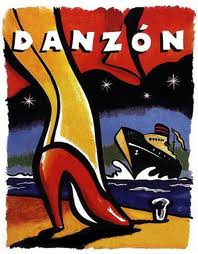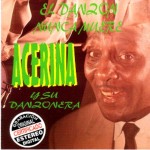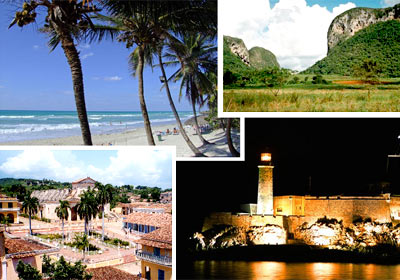THE DANZON: BORN IN CUBA AND WENT TO MEXICO TO STAY. ‘ACERINA’.
It was the month of December 1884 in the Mexican ‘Lonja de Merida’, a huge space with great taste that delighted the audience with performances of the “danzones” of Cuban maestro Arturo Cosgaya along with Cuevas.
Mestizos and Indians alternated with the proud ladies all dressed up in tight corset, silk, ruffles, lace, velvet and ribbons of their syrupy dresses, which finished off in the back with a large bow or stowaway Yucatan garment known as “follow me chicken’ and in Cuba as “Bullaranga” according to historians. The gentlemen, who were not far behind, with understated elegance draculesca somewhat, vests, pants and dark jaquets medals and decorations crammed fictitious or real, danced Danzon, or at least I thought, because I never could interpret freely.
Since the beginning of the year 1879 in Matanzas, Cuba Failde the musician Miguel Failde Perez had invented this elegant and moved rhythm that ships coming from Havana as the “Apollo”, “Yucatan”, “Coahuila” and “Cuba” were watering along the coast of the Gulf of Mexico with the cadence of that delicious and innovative rhythm. At the beginning were the European, aristocratic and upper classes in Yucatan who danced it but as separated from the other dancer, with floral arches, resembling the quadrille, inherited from the earliest rhythms brought by the French who fled from Haiti to Cuba when the revolution in that country.
A dance hall, a cinema dancing, brothels and cabarets, the Danzon musically exploded between 1910 and 1920 approximately, somewhat modest, serious and devoid of taste that first gave Mexican dancers, who you were printing time life liturgy, form and diversity to its original character reintegrating somewhat lewd and erotic. Similar appropriation at different stages you had applied Cuba mulatto musicians.
Orchestras authentic Cuban flavor coexisted with the enthusiasm of the genre then it was also sometimes accompanied with other genres and styles as was the son, rumba and Cuban Guaracha. They tell the old carnival that Cuba during evenings were armed “shindig” and the island could hear the sound of the panchanga to Puerto Progreso, could hear the rumbón and danzoneo and you could see the glow of artificial lights. During the 20’s in Progress parties were held in the Cuban, the difference was that in the printed black population island flavor, rhythm and joy.
Among the many groups of the orchestra were then Esmeralda, Julian Molina teacher, that of Alfonso Baqueiro excellent teacher danzón Ruben Dario Herrera and Clara Charter danzón hugely popular, as well as Daniel Ayala Pérez, Pedro Calderon and Hoil of Juan Concha.
It was definitely in Mexico where the Danzon took up residence, this genre of Cuban, was in Mexico where he was welcomed as a way to appreciate music in a special way, to the point that the legendary “SALON MEXICO” almost century establishment He was baptized at the time as ‘the cathedral of Danzon’, was devoted almost exclusively to submit to Danzon for over fifty years without interruption.
THE CUBAN MUSICIAN CONSEJO VALIENTE ROBERTS “ACERINA” AND HIS DANZONERA.
Speaking of the Master and Cuban musician Consejo Valiente “Acerina” is the same as speaking of Danzon, its beginnings, its growth and how it took root in Mexico. Acerina was born in the city of Santiago de Cuba on April 16, 1899 and died on June 6, 1987 in Mexico at the age of 88. From boy he took to the drums, something he inherited from his father who was also a musician and Mambí.
His stepfather Enrique Bueno, also a musician and who had created an orchestra with his name and was very popular in the late nineteenth century in Santiago de Cuba, was inserted as a drummer in his group counting ‘Acerina’ with only 12 years of age, with he learns enough of theory and music theory music. After a short time the young leaves to Veracruz, Mexico, in 1913, ie only 14 years old and steeped in blood Danzon, so it manages to incorporate as a drummer in the orchestra Danzon precursor in Mexico, Tiburcio Hernández ” Babuco “.
Already in 1927 another famous orchestra enters danzón, the director Juan de Dios Concha, the most requested at the time in the Aztec country. Over the months Consejo Valiente “Acerina” began and remained acting in the “Salon Mexico”, the most famous and most reputable in the country, for many years, where he performed with his own band “ACERINA and His Danzonera”, remaining active for a long during which never stopped directing and interpret their memorable songs, composing, and local recognition made room for so many years, one of his biggest hits, such as “SALON MEXICO”.
Not counting that recorded danzons alternating with Perez Prado and Sonora Matancera, Council Brave ‘Hematite’ recorded over 150 danzons they did dance around Mexico, including 36 of his own inspiration.
In 1981 Acerina gives your music file and its direction of the orchestra master Diego Perez and Reyes. To date, we know this musician, preserves and promotes the style that for many years had instituted his master, thus generating the Mexican Danzon.
The Sound “ACERINA” has earned its authentic Mexican definition. In Mexico is still hearing from border to border, the Danzon. A Culture, a genre that can be said is both Cuba and Mexico.
Danzon is not a work of a race, a nation or a continent as groups and individuals through the localization process have appropriated this dance, resignificándolo as part of “tradition” broad-ranging dance of the country.
Danzon, born in Cuba, but from its dissemination in the areas bordering the Gulf of Mexico and Caribbean would become a multinational rate today is motivating the emotion and sensitivity of musicians and dancers around the world.
Wiki/Blogero/AVarona/Excerpt/InternetPhotos/Thecubanhistory.com
The Cuban History, Hollywood.
Arnoldo Varona, Editor
EL DANZÓN: NACIÓ EN CUBA Y LLEGÓ A MÉXICO PARA QUEDARSE. ‘ACERINA’.
Corria el mes de Diciembre de 1884 en la mexicana ‘Lonja de Merida’ que complacía con gran gusto a los asistentes con candentes interpretaciones de los danzones cubanos del maestro Arturo Cosgaya junto con los de Cuevas.
Mestizos e indígenas alternaban con las emperifolladas damas de contenidas carnes en el apretado corsé, las sedas, olanes, encajes, terciopelos y listones de sus almibarados vestidos, que remataban en la parte trasera con un gran moño o polizón, prenda conocida en Yucatán como “sígueme, pollo” y en Cuba como “bullaranga” según los historiadores. Los señores, que no se quedaban atrás, con sobria elegancia un tanto draculesca, chalecos, pantalones y jaquets obscuros atiborrados de preseas y condecoraciones ficticias o verdaderas, bailaban danzón, o por lo menos eso pensaron, pues nunca pudieron interpretarlo libremente.
Desde principio del año 1879 en Matanzas, Cuba el musico Miguel de Failde Pérez habia compuesto el entonces elegante y movido ritmo que los barcos procedentes de la Habana como el “Apolo”, “Yucatan”, “Coahuila” y el “Cuba” fueron regando por las costas del Golfo de México con la cadencia de ese delicioso e innovador ritmo. Al comienzo tenía un aire europeo y aristocrático y las mismas clases altas en Yucatan tambien lo danzaba pero separado de la pareja, con arcos de flores, semejante a la contradanza, heredada de los primeros ritmos llevados por los franceses que huyeron de Haiti cuando la revolución en aquel país.
A los salones de baile, dancing de cinematógrafo, prostíbulos y cabarets, el danzón explotó musicalmente entre los años 1910 y 1920 aproximadamente, un tanto recatado, serio y exento del gusto que le dieron primeros bailadores mexicanos; quienes el tiempo le fueron imprimiendo vida, liturgia, forma y diversidad, reintegrándolo a su original carácter un tanto lascivo y erótico. Similar apropiación que en sus diferentes etapas le habian aplicado los músicos mulatos de Cuba.
Orquestas de auténtico sabor cubano convivieron con el entusiasmo de el genero entonces que tambien era acompañado a veces con otros géneros y estilos como era el son, la rumba y la guaracha cubana. Narran los viejos que durante los carnavales de Cuba se armaban las noches de “guateque” y de la isla se escuchaba el rumor de la panchanga hasta Puerto Progreso; se escuchaba el rumbón y el danzoneo y se podía observar el resplandor de las luces artificiales. Durante los años 20’s en Progreso las fiestas se celebraran a lo cubano, la diferencia era que en la isla la poblacion negra imprimia el sabor, el ritmo y la alegría.
Entre las muchas agrupaciones de entonces estaban la orquesta Esmeralda, del maestro Julián Molina; la de Alfonso Baqueiro, la excelente danzonera del maestro Rubén Darío Herrera y la popularísima danzonera Carta Clara, así como las de Daniel Ayala Pérez, Pedro Hoil Calderón y las de Juan Concha.
Fue definitivamente en Mexico donde el Danzón se residenció; este género musical de origen cubano, fue en México donde se le acogió como una forma de apreciar la música de una manera especial, hasta el punto que el legendario “SALÓN MÉXICO”, establecimiento casi centenario que fue bautizado en su día como ‘la catedral del danzón’, se dedicó casi exclusivamente a presentar al danzón durante más de cincuenta años sin interrupción.
EL CUBANO CONSEJO VALIENTE ROBERTS “ACERINA” Y SU DANZONERA.
Hablar del Maestro y músico cubano Consejo Valiente “Acerina”, es lo mismo que hablar del danzón, de sus comienzos, de su crecimiento y de la forma en que se enraizó en México. Acerina nació en la ciudad de Santiago de Cuba el 16 de abril de 1899 y falleció el 6 de junio de 1987 en México a la edad de 88 años. Desde niño se aficionó a la percusión, algo que heredó de su padre quién también era músico y mambí.
Su padrastro Enrique Bueno, tambien músico y quien había creado una orquesta con su nombre y fue muy popular a finales del siglo XIX en Santiago de Cuba, lo insertó como timbalero en su agrupación contando ‘Acerina’ con solo 12 años de edad, es con él que aprende bastante de teoría y solfeo de la música. Pasado un corto tiempo el joven se marcha para Veracruz, México, en 1913, es decir con solo 14 años y el danzón impregnado en la sangre, es así que logra incorporarse como timbalero en la orquesta del precursor del danzón en México, Tiburcio Hernández “Babuco”.
Ya en el año 1927 ingresa en otra famosa orquesta danzonera, la del director Juan de Dios Concha la más solicitada en aquellos momentos en el país azteca. Con los meses Consejo Valiente Robles “Acerina” comenzó y se mantuvo actuando en el “Salón México”, el más famoso y de mayor reputación del país, por muchos años, donde se presentaba con su propia orquesta “ASERINA Y SU DANZONERA”, permaneciendo activo, por un largo durante el cual jamas dejó de dirigir e interpretar sus memorables temas musicales, componiendo, como reconocimiento al local que le dio cabida durante tantos años, uno de sus temas mas famosos, como es “SALÓN MÉXICO”.
Sin contar los danzones que grabó alternando con Pérez Prado y la Sonora Matancera, Consejo Valiente ‘Acerina’ grabó mas de 150 danzones que hicieron bailar a todo México, entre ellos 36 de su propia inspiración.
En 1981 Acerina cede su archivo musical y la direccion de su orguesta al Maestro Diego Perez y Reyes . Hasta hoy, que sepamos este musico, conserva y promueve el estilo que por muchos anos habia instituido su maestro, generando asi el Danzon mexicano.
El Sonido “ACERINA” ha ganado su autentica definicion mexicana. En México se sigue escuchando de frontera a frontera, el danzón. Un Cultura, un género que se puede decir es tanto de Cuba como de México.
El danzón no es una obra de una raza, un pueblo ó un continente ya que los grupos e individuos a través del proceso de localización se han apropiado de este baile, resignificándolo como parte de “la tradición” dancística del pais.
El danzón, nació en Cuba, pero a partir de su difusión en las áreas ribereñas del Golfo de México y del Caribe se convertiría en un ritmo multinacional que hoy sigue motivando la emoción y la sensibilidad de músicos y bailarines alrededor del mundo.
Wiki/Blogero/AVarona/Excerpt/InternetPhotos/Thecubanhistory.com
The Cuban History, Hollywood.
Arnoldo Varona, Editor






